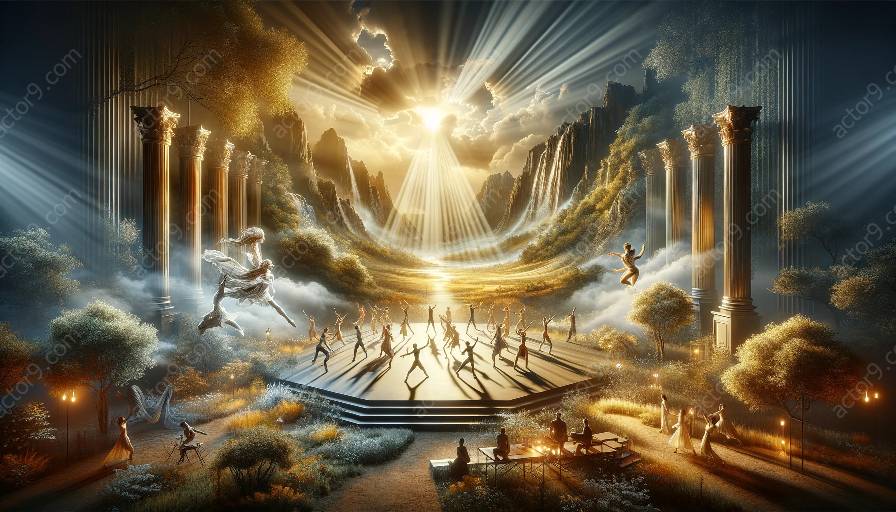Physical theatre relies on the interplay of movement, space, and visual elements to convey storytelling and evoke emotions. One crucial aspect of this interplay is the role of lighting in guiding audience focus and enhancing the audience's experience.
When considering the role of lighting in physical theatre, it's important to recognize that lighting design is not solely about illuminating the performers or the stage. Instead, it serves as a dynamic tool that shapes the audience's perception and directs their attention. In this topic cluster, we will delve into the multifaceted nature of lighting in physical theatre and explore how it influences the audience's engagement with the performance.
The Art of Physical Theatre: A Unique Form of Expression
Before delving into the role of lighting, it's essential to understand the essence of physical theatre as a distinctive form of expression. Physical theatre transcends traditional dialogue-driven storytelling and relies on the performers' bodies, movements, and gestures to convey narratives, emotions, and themes. This dynamic art form often blurs the boundaries between dance, drama, and visual spectacle, resulting in a captivating and immersive experience for the audience.
Within the realm of physical theatre, the use of lighting becomes an integral component in shaping the audience's perception and engagement. The strategic manipulation of light can transform the performance space, accentuate the performers' movements, and evoke specific moods or atmospheres that complement the narrative. As a result, lighting design becomes a collaborative art form that intertwines with the choreography, set design, and soundscapes to create a cohesive and compelling visual experience.
Guiding Audience Focus: Illuminating the Performer's Journey
Lighting design in physical theatre plays a pivotal role in guiding the audience's focus and shaping their visual journey throughout the performance. By carefully orchestrating lighting cues, designers can draw attention to specific performers or elements within the stage, emphasizing critical moments or emotions within the narrative. This intentional manipulation of light allows for a dynamic interplay between visibility and obscurity, creating a sense of depth, rhythm, and focal points within the performance space.
Furthermore, lighting serves as a means of sculpting the spatial dynamics within physical theatre. Through the artful use of shadows, contrasts, and color palettes, lighting design accentuates the performers' interactions with the environment and conveys the physicality of their movements. By harnessing the interplay of light and shadow, physical theatre productions can imbue depth and dimension into their storytelling, enriching the audience's perceptual engagement with the performance.
Enhancing Emotional Resonance: The Emotional Impact of Lighting
Beyond its functional role in guiding audience focus, lighting in physical theatre possesses the transformative power to evoke emotional resonance and create immersive atmospheres. The interplay between light and shadow can elicit a myriad of emotional responses, ranging from suspense and mystery to intimacy and introspection. When utilized strategically, lighting becomes a silent storyteller, shaping the audience's emotional journey and augmenting the narrative's thematic elements.
Moreover, the versatility of lighting design allows for seamless transitions between scenes and moods, seamlessly transporting the audience across different emotional landscapes. Whether through subtle shifts in color temperature or dramatic changes in lighting dynamics, designers can manipulate the ambience of the performance space, crafting an ever-evolving visual landscape that mirrors the thematic nuances of the production.
Immersive Experiences: The Intersection of Lighting and Audience Engagement
The role of lighting in physical theatre extends beyond mere illumination; it intertwines with the concept of audience engagement and immersion. Lighting design has the potential to envelop the audience within the narrative, blurring the boundaries between the physical and emotional realms. By strategically modulating the intensity, direction, and quality of light, designers can sculpt immersive environments that invite the audience to become active participants in the visual storytelling.
For the audience, experiencing physical theatre becomes a sensorial voyage that is intricately woven with the nuances of lighting. The interplay of light and shadow becomes a conduit through which emotions, tensions, and resolutions are expressed, deepening the audience's connection with the performers and the narrative unfolding before them. As such, lighting design serves as a bridge between the ephemeral nature of physical theatre and the enduring impact it leaves on the audience's senses and emotions.
Technical Innovation and Artistic Collaboration
When exploring the role of lighting in physical theatre, it's essential to acknowledge the intricate technical innovations and artistic collaborations that underpin the craft of lighting design. Lighting designers work in tandem with directors, choreographers, and other creative stakeholders to sculpt visual narratives that seamlessly integrate with the performers' movements and the thematic essence of the production.
Advancements in lighting technology and techniques have expanded the creative possibilities within physical theatre, offering designers a dynamic palette to express their artistic vision. From the use of intelligent lighting fixtures to interactive projections, the marriage of technical innovation and artistic collaboration fosters an environment where lighting design evolves beyond traditional paradigms, enriching the storytelling potential of physical theatre.
Conclusion
In conclusion, the role of lighting in guiding audience focus in physical theatre represents a multifaceted interplay between artistic expression, technical innovation, and audience engagement. Lighting design transcends its utilitarian function and becomes a transformative force that shapes the visual narrative and emotional resonance of physical theatre productions. By understanding the intricate dynamics of lighting within physical theatre, we gain a deeper appreciation for the symbiotic relationship between illumination and the art of storytelling through movement, ultimately enhancing the overall experience for both performers and audience members.




































